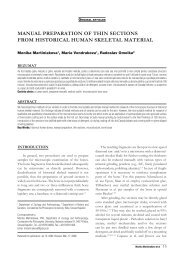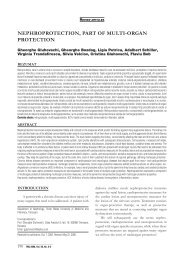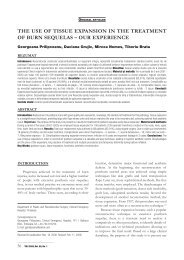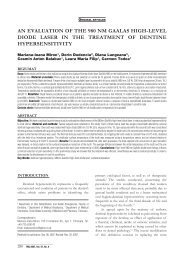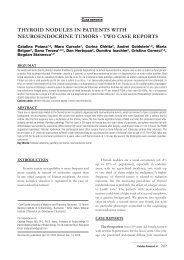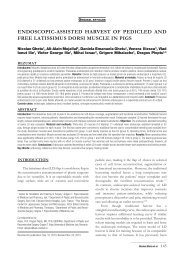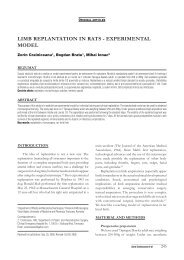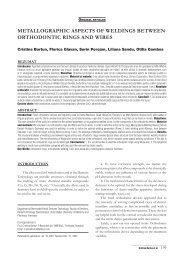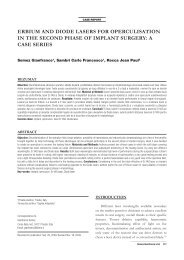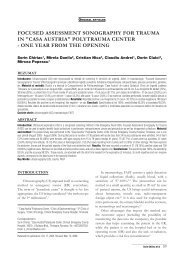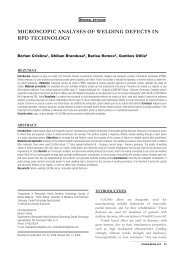greater trochanteric pain syndrome: what is this meaning?
greater trochanteric pain syndrome: what is this meaning?
greater trochanteric pain syndrome: what is this meaning?
Create successful ePaper yourself
Turn your PDF publications into a flip-book with our unique Google optimized e-Paper software.
solution for the treatment of refractory <strong>trochanteric</strong><br />
bursit<strong>is</strong> when conservative measures have failed.<br />
The recalcitrant TB can sometimes be addressed<br />
with arthroscopic bursectomy and/or ITB release. The<br />
use of arthroscopy to treat recalcitrant <strong>trochanteric</strong><br />
bursit<strong>is</strong> <strong>is</strong> reported and its role in treating th<strong>is</strong> common<br />
clinical entity <strong>is</strong> d<strong>is</strong>cussed. Fox et al. 41 showed that<br />
arthroscopically performed <strong>trochanteric</strong> bursectomy<br />
<strong>is</strong> a minimally invasive technique that appears to be<br />
both safe and effective for treating recalcitrant <strong>pain</strong><br />
<strong>syndrome</strong>s. Farr et al. 44 believe that the iliotibial band<br />
must be addressed and <strong>is</strong> the main cause of <strong>pain</strong>,<br />
inflammation, and <strong>trochanteric</strong> impingement leading<br />
to the development of bursit<strong>is</strong> and report a new<br />
technique for arthroscopic <strong>trochanteric</strong> bursectomy<br />
with iliotibial band release.<br />
Septic bursit<strong>is</strong> <strong>is</strong> unusual in the hip bursa but does<br />
occur. The bursal fluid can be examined in the laboratory<br />
for the microorgan<strong>is</strong>ms causing the infection. 45 Septic<br />
bursit<strong>is</strong> <strong>is</strong> caused by the Staphylococcus aureus. Th<strong>is</strong> <strong>is</strong><br />
confirmed by antibiogram from the fluid in the bursa<br />
and requires antibiotic treatment. When a patient has<br />
such a serious infection, there may be underlying causes.<br />
There could be und<strong>is</strong>covered diabetes, or an inefficient<br />
immune system caused by human immunodeficiency<br />
virus infection (HIV). 46 Repeated aspiration of the<br />
infected fluid may be required. Surgical drainage and<br />
removal of the infected bursa may also be necessary. 47<br />
CONCLUSIONS<br />
Trochanteric bursit<strong>is</strong> <strong>is</strong> a common cause of hip<br />
and leg <strong>pain</strong>. Hip <strong>pain</strong> brings patients to health care<br />
providers, including both primary care and specialty<br />
providers. Causes of hip <strong>pain</strong> often are attributed to<br />
d<strong>is</strong>orders in the lower back or hip joint. R<strong>is</strong>k factors for<br />
th<strong>is</strong> d<strong>is</strong>order include obesity, female gender, overuse<br />
and altered gait mechanics.<br />
MR imaging and plain radiographs provide<br />
detailed information about the anatomy of tendinous<br />
attachments of the abductor muscles and the bursal<br />
complex of the <strong>greater</strong> trochanter.<br />
In most cases the d<strong>is</strong>order <strong>is</strong> self-limiting, with<br />
treatment cons<strong>is</strong>ting of conservative measures such<br />
as behaviour modification, physical therapy, weight<br />
loss, and nonsteroidal anti-inflammatory drugs. When<br />
these interventions fail, bursa injections with local<br />
admin<strong>is</strong>tration of a mixture of corticosteroid and<br />
local anaesthetic have been shown to provide good<br />
<strong>pain</strong> relief. A specific and goal-directed rehabilitation<br />
program often seems quite reasonable. Physical<br />
therapy can be incorporated to teach the patient a<br />
home exerc<strong>is</strong>e program, emphasizing stretching of<br />
the ITB, tensor fascia lata (TFL), external hip rotators,<br />
quadriceps, and hip flexors.<br />
Arthroscopic bursectomy appears to be an<br />
effective option for recalcitrant <strong>trochanteric</strong> bursit<strong>is</strong><br />
and <strong>is</strong> a viable alternative to open bursectomy. Greater<br />
trochanteic bursit<strong>is</strong> <strong>is</strong> often underdiagnosed as a cause<br />
of hip <strong>pain</strong> despite its character<strong>is</strong>tic symptoms of<br />
diffuse <strong>pain</strong> in the buttocks and lateral thigh. Because<br />
<strong>greater</strong> <strong>trochanteric</strong> bursit<strong>is</strong> <strong>is</strong> so common and fairly<br />
responsive to treatment, it <strong>is</strong> important for health care<br />
providers to include th<strong>is</strong> diagnos<strong>is</strong> in their differential<br />
diagnos<strong>is</strong> when evaluating hip <strong>pain</strong>.<br />
ACKNOWLEDGEMENTS<br />
It <strong>is</strong> a great pleasure to thank our superv<strong>is</strong>or, Dr.<br />
Renzo Bianchi.<br />
REFERENCES<br />
1. Leonard MH. Trochanteric <strong>syndrome</strong>; calcareous and noncalcareous<br />
tendonit<strong>is</strong> and bursit<strong>is</strong> about the trochanter major. J Am Med Assoc<br />
1958;168:175–7.<br />
2. Shapira D, Nahir M, Shcharf Y. Trochanteric bursit<strong>is</strong>: a common<br />
clinical problem. Arch Phys Med Rehabil 1986;67:815-7.<br />
3. Adkins SB, Figler RA. Hip <strong>pain</strong> in athletes. American Family Physician<br />
2000;61(7):2109-18.<br />
4. Shbeeb MI, Matteson EL. Trochanteric bursit<strong>is</strong> (<strong>greater</strong> trochanter<br />
<strong>pain</strong> <strong>syndrome</strong>). Mayo Clin Proc 1996;71:565-9.<br />
5. Tortolani PJ, Carbone JJ, Quartararo LG. Greater <strong>trochanteric</strong> <strong>pain</strong><br />
<strong>syndrome</strong> in patients referred to orthopedic spine special<strong>is</strong>ts. Spine<br />
J 2002;2:251–4.<br />
6. Alvarez-Nemegyei J, Canoso JJ. Evidence-based soft t<strong>is</strong>sue rheumatology:<br />
III: <strong>trochanteric</strong> bursit<strong>is</strong>. J Clin Rheumatol 2004;10:123–4.<br />
7. Swezey RL. Pseudo-radiculopathy in subacute <strong>trochanteric</strong> bursit<strong>is</strong><br />
of the subgluteus maximus bursa. Arch Phys Med Rehabil<br />
1976;57:387-90.<br />
8. Sayegh F, Potoupn<strong>is</strong> M, Kapetanos G. Greater trochanter bursit<strong>is</strong> <strong>pain</strong><br />
<strong>syndrome</strong> in females with chronic low back <strong>pain</strong> and sciatica. Acta<br />
Orthop Belg 2004;70:423–428..<br />
9. Collee G, Dijkmans BA, Vandenbroucke JP, et al. A clinical<br />
epidemiological study in low back <strong>pain</strong>. Description of two clinical<br />
<strong>syndrome</strong>s. Br J Rheumatol 1990;29:354-7.<br />
10. Chr<strong>is</strong>tmas C, Crespo CJ, Franckowiak SC, et al. How common <strong>is</strong> hip<br />
<strong>pain</strong> among older adults? Results from the Third National Health<br />
and Nutrition Examination Survey. J Fam Pract 2002;51:345–8.<br />
11. Segal NA, Felson DT, Torner J, et al. Greater <strong>trochanteric</strong> <strong>pain</strong><br />
<strong>syndrome</strong>: epidemiology and associated factors. Arch Phys Med<br />
Rehabil 2007;88(8):988-92.<br />
12. Dunn T, Heller CA, McCarthy SW, Dos Remedios C. Anatomical study<br />
of the “<strong>trochanteric</strong> bursa.” Clin Anat 2003;16:233–40.<br />
13. Woodley SJ, Mercer SR, Nicholson HD. Morphology of the bursae<br />
associated with the <strong>greater</strong> trochanter of the femur. J Bone Joint<br />
Surg Am 2008;90:284–94.<br />
14. Little H. Trochanteric bursit<strong>is</strong>: a common cause of pelvic girdle <strong>pain</strong>.<br />
Can Med Assoc J 1979;120:456–8.<br />
15. Schapira D, Nahir M, Scharf Y. Trochanteric bursit<strong>is</strong>: a common clinical<br />
problem. Arch Phys Med Rehabil 1986;67:815–17.<br />
16. Cohen SP, Raja SN. Pathogenes<strong>is</strong>, diagnos<strong>is</strong>, and treatment of lumbar<br />
zygapophysial (facet) joint <strong>pain</strong>. Anesthesiology 2007;106:591–614.<br />
17. Johnston CA, Wiley JP, Lindsay DM, W<strong>is</strong>eman DA. Iliopsoas bursit<strong>is</strong><br />
and tendinit<strong>is</strong>. A review. Sports Med 1998;25:271–83.<br />
_____________________________<br />
Alessandro Geraci et al 79



